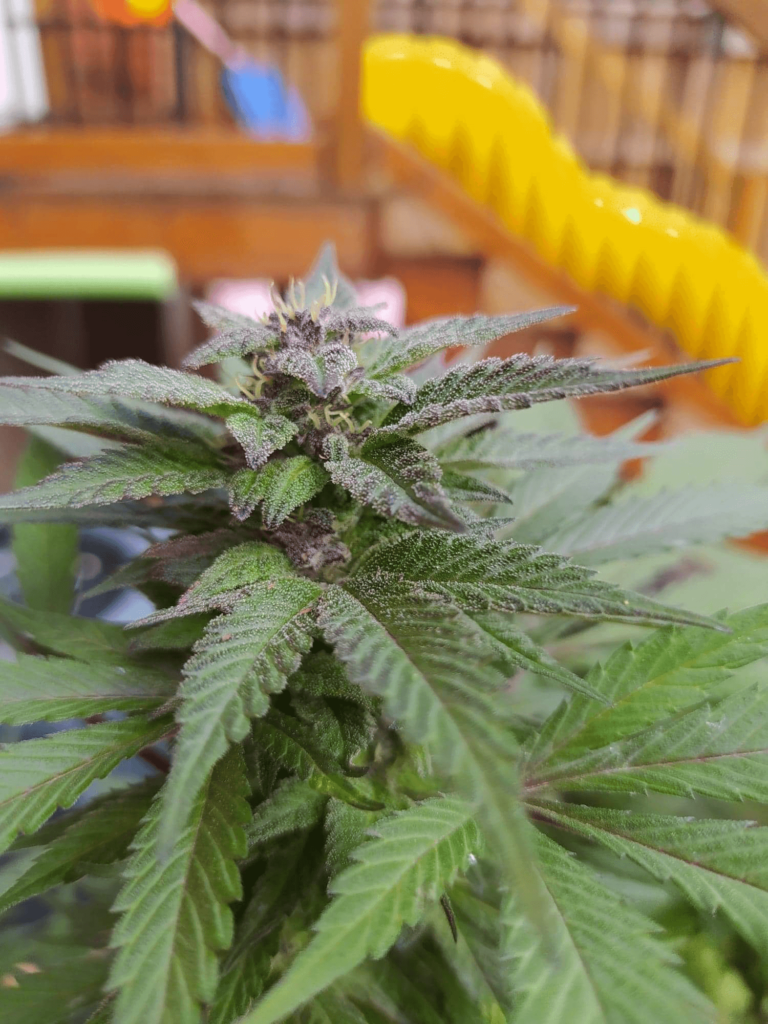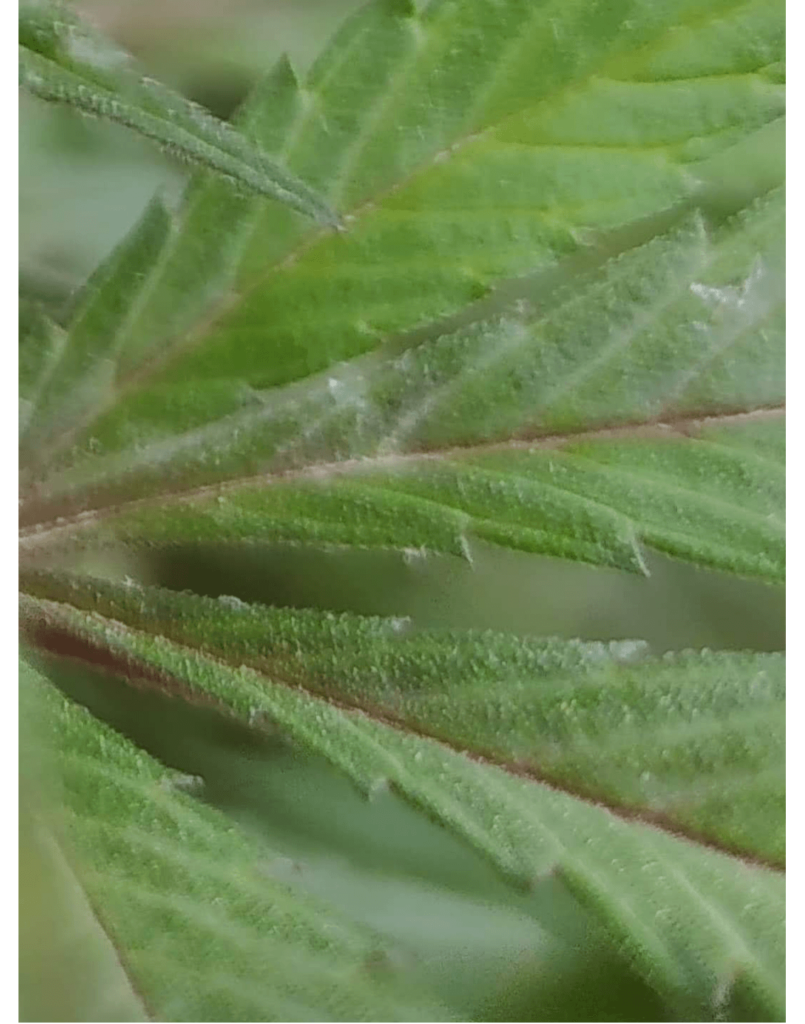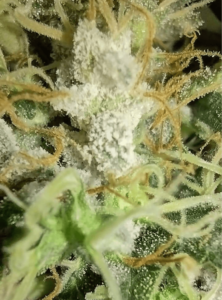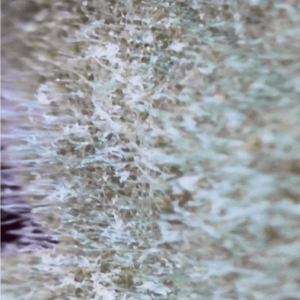My Story with White Powdery Mildew: I was having an excellent veg cycle. Every day the plant was getting bigger and the leaves were getting dense and massive—some had 11 fingers and were almost the size of my head! Temperatures were in a good range, around 80 degrees Fahrenheit, but the RH (Relative Humidity) was running a bit high—about 80% RH—but by the looks of it things were going great!
What I did not notice was a spotting of whitish-gray patches developing on some of the leaves. When I finally saw it the white fuzzy patches had grown to about the size of a quarter in several places. I was surprised—what the heck is this stuff and what’s going on? I had to figure this out.
It was a case of White Powdery Mildew, or WPM, named appropriately due to its fuzzy white appearance. It is a common plant disease that can affect many plants, not just cannabis: flowers like dahlias, sunflowers, begonias, and roses and many vegetables like melons, tomatoes, peppers, and lettuces can all suffer from this disease, though many say that mildew from one plant species does not jump to a different one.
From my experience this is true: years ago I had sunflowers infected with White Powdery Mildew\WPM which never infected my cannabis plant growing close by. (As an aside, I was kind of surprised because the sunflowers had grown so huge that I couldn’t treat them properly, so the mold ran rampant.)


What is White Powdery Mildew\WPM?
White Powdery Mildew\WPM is actually a fungus from the Erysiphales family that can reproduce both sexually and asexually. It attacks the aerial parts of plants like the leaves, stems, fruits, and flowers. They have a superficial mycelium, a root-like structure made of the branching fungus that then attaches to the plant and embeds itself into the plant’s epidermal cells. So, White Powdery Mildew\WPM is not just sitting on the surface of the leaf, it is actually parasitic and pulls the plant’s resources directly out of it.
If left unchecked, the fungus will take over and kill the plant. Luckily, White Powdery Mildew\WPM can usually be controlled and plants with WPM can still produce a decent crop. WPM also compromises photosynthesis since it covers leaves, meaning it prevents light from penetrating to the leaves, so WPM can be very dangerous to your plant if you let it get out of control.
WPM normally appears on leaves first so be sure to examine your plants carefully. From there, WPM matures and the spores can be carried through the air by wind to other host plants. WPM is normally not dangerous to people but flowers infected with WPM are not safe to consume or smoke. You’ll know if you’ve consumed WPM if you have feelings of vertigo or brain fog, and in bad cases, it can cause respiratory infections and lung disease.
Once identified, white powdery mildew is easy to treat and manage, but the best defense is prevention through maintaining an environment that is inhospitable to it. WPM loves humidity and will thrive in high RH above 65%. It travels by airflow so wind and fans can help spread the infection in your grow room or outdoor grow, or it can be carried in on clothing, especially if you’ve been in your friend’s cloning grow room.
When your plant has dense foliage where leaves are so thick that they prevent the proper flow of air you’ll get humid spots in the canopy and this is exactly where WPM likes to grow.


Signs of Powdery Mildew on Cannabis
Identifying and addressing powdery mildew in cannabis cultivation is paramount for maintaining plant health and maximizing yields. As a cultivation expert, I’ll outline the signs of powdery mildew and offer insights on prevention and treatment strategies, supported by data and practical experience.
1. Visual Symptoms:
Powdery mildew initially appears as white or grayish powdery spots on the leaves, stems, and buds of cannabis plants. These spots may resemble flour or dust and often develop on the upper surfaces of leaves.
As the infection progresses, the powdery patches can spread rapidly, covering larger areas of the plant. Severe infestations can lead to leaf distortion, yellowing, and premature leaf drop, ultimately compromising plant health and productivity.
2. Fungal Growth and Spores:
Powdery mildew is caused by fungal pathogens belonging to the Erysiphales order, primarily the genus Podosphaera and Golovinomyces.
Under favorable environmental conditions, such as high humidity and moderate temperatures, powdery mildew spores thrive and spread rapidly, infecting nearby plants and creating ideal conditions for disease development.
3. Environmental Factors:
Powdery mildew thrives in environments with high humidity levels (above 50-60%) and moderate temperatures (around 68-77°F or 20-25°C). Poor air circulation and crowded plant spacing can exacerbate the spread of the disease.
Research indicates that controlling environmental factors, such as maintaining proper humidity levels, adequate airflow, and spacing between plants, can help prevent powdery mildew outbreaks and limit disease progression.
4. Prevention and Management Strategies:
Implementing preventive measures is crucial for managing powdery mildew in cannabis cultivation. These include:
-
- Regular monitoring for early signs of infection.
- Maintaining proper airflow and ventilation in growing spaces.
- Pruning and removing affected plant parts to reduce disease spread.
- Applying preventive fungicides or botanical extracts with antifungal properties.
Cultural practices such as selecting resistant cultivars and avoiding overhead watering can also help minimize the risk of powdery mildew.
In conclusion, recognizing the signs of powdery mildew and understanding its underlying causes are essential for effective disease management in cannabis cultivation.
Is Moldy Weed Edible?
It is not advisable to consume moldy cannabis as it can pose potential health risks. Mold on cannabis produces mycotoxins, toxic substances that can lead to various health problems upon ingestion. Mycotoxins can impact the respiratory system, gastrointestinal tract, and may even result in neurological issues in severe instances.
Symptoms of consuming moldy cannabis may manifest as respiratory issues, nausea, vomiting, diarrhea, headaches, dizziness, and in severe cases, allergic reactions or fungal infections in the lungs. Therefore, it is essential to ensure that your cannabis is mold-free before consumption.
How to Treat White Powdery Mildew/WPM?
If White Powdery Mildew\WPM does make it into your grow room there are several ways to treat it.
First, assess the condition and severity of the infection: look for white powdery mildew on leaves, under leaves, on stems, and even on and in the buds. If WPM gets into your buds those buds are no longer safe to consume. Cut it any buds infected with WPM off and discard them in the trash—do not compost them because the WPM will just end up back in your soil and will be ready to infect new plants and crops. If it has covered most of the leaf, cut it off and dispose of it in the trash, the same as you would for any infected part of a plant.
Leaves with minor infections can be manually cleaned off with a solution of 1 part H2O2 (regular 3% Hydrogen Peroxide) and 9 parts water. Go around and clean off any areas that have any sign of infection and be careful not to spread the spores to other areas, be sure to change gloves and use hand sanitizer often. Cut paper towels into pieces and use 1 or 2 on each leaf and then discard the used paper towels. Use a new piece of paper towel on each leaf if possible. Don’t be too rough—you do not want to injure the plant by opening up tears in the leaves.


After treatment, your plant should look a lot better, but we’re not done yet. We want to control the WPM in your grow space now so that it never comes back—if you don’t clean and change your growing condition, you’ll eventually see it sprout up again. There are a few store-bought organic remedies like “Trifecta Crop Control” that is safe to spray even during the flowering stage. For a lot of growers, they rely on a few tried-and-true home remedies, so maybe there are a few recipes that can work for you:
One recipe is 2 tablespoons of baking soda (directly treats the WPM), 1 table spoon of non-fragrant organic soap that also helps with aphids that like to attack weakened plants, 1 tablespoon of vegetable oil to help it stick the solution to the plant, and 4 cups of water. Mix the ingredients well and use a fine mist sprayer to apply as a foliar spray. Spray down the whole plant, except the buds.
If you have WPM on your buds cut your losses and dispose of the infected area. Spray the soil and surrounding areas also. It may be necessary to apply a follow-up spray every week to keep WPM from coming back and spreading.
The next step we need to take is to change our environment to ensure WPM doesn’t have a suitable place to grow. First, clean the room: this includes the walls, the equipment, the floor, and the roof or ceiling, by spraying with a water and bleach solution.
Additionally, air circulation is a key component to prevent the return of WPM. You may need to add a few fans to improve airflow around the plant to keep it from collecting moisture. Defoliation of heavily dense areas can help to open it up and allow better airflow to prevent humidity from collecting in areas where WPM grows. For temperature, steady or gradual temperature fluctuations are better than sudden changes, which cause condensation. Rapid wet-then-dry cycling is something WPM loves. Also, keep your nutrients from splashing from the soil onto your plants—nutrients can help WPM grow pretty quickly.
Finally, a Hepa air filter in your grow room or an air scrubber will help filter out WPM spores. Keep the air clean of contaminants that may be looking for a place to nest. Another good prevention is carefully selecting particular strains that are more resistant.
I hope this helps you think of some different ways to deal with what is sadly a common problem when growing cannabis. Luckily, WPM isn’t a death sentence for your plant, but remember, prevention is easier and better than treatment! That’s why you should sign up for our newsletter where we share helpful tips from professional growers that will help you prevent or solve a lot of common problems that everyone faces eventually.
As always if you have any questions you can message our Instagram or Facebook and we’ll be glad to help you out! We’re happy you’re on this journey and we want to help in any way we can.
Subscribe to the Vivosun newsletter for growing tips, grower stories, and special offers, and get 12% off your first order!
We love the new Vivosun Smart Grow System and we are certain that you too will love it once you try it.
And join our Facebook farmer’s community for even more exclusive contests and prizes!
Download Vivosun App to get 15% off and explore more information!


Vee
Vee is an indoor cultivation expert specializing in tropical plants and cannabis cultivation. With extensive experience in various indoor growing setups, she excels in optimizing growth environments to maximize plant health and yield. Through hands-on experience with a variety of cultivation equipment, Vee has developed a deep understanding of indoor growing techniques. Passionate about sharing her knowledge, she empowers enthusiasts through articles, workshops, and online forums. Vee is dedicated to pushing the boundaries of indoor cultivation, whether assisting commercial operations or hobbyists, with practical and effective strategies.











